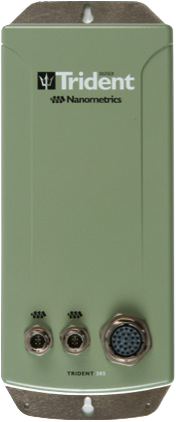Home / Products / Seismology / Trident 305 Digitizer
Trident 305 Digitizer
Summary
The Trident 305 is an industry-leading digitizer, designed for use with the Taurus Portable Seismograph or Cygnus transceiver. The Trident 305 features 24-bit performance in a compact, robust package offering typical dynamic range of 142 dB.
The Trident 305 Digitizer’s versatility allows for an optimal network design flexibility. Numerous Trident 305 digitizers can be daisy-chained to form a multi-channel system. Such scalability makes Trident 305 well suited to fixed, portable and structural monitoring networks.
Because the Trident 305 Digitizer includes comprehensive seismometer control functions, it allows for seismometer mass centering, mass positioning, monitoring and calibration from a central site, eliminating the need for frequent site visits.
Since the Trident 305 is not packaged with communications interface and timing systems, it can be deployed within the seismometer vault’s temperature-stable environment for improved long-period performance and superior data quality.
In addition, the Trident 305 Digitizer supports bi-directional data communications, timing and power distribution, allowing for a simple twisted-pair NMXbus cable between the digitiser and the communications interface. This feature eliminates the need to use long RF and GPS cables to accommodate the positioning of GPS, VSAT or RF antenna, reducing cost and increasing site configuration options.

Benefits
- Superior performance, true 24-bit resolution with 142 db dynamic range
- Versatile software programmable front-end gain to support a wide range of sensor types
- Remote mass centering and calibration functions, ideal for broadband applications
- NMXbus technology provides freedom in placing remote site components
- Complete system response calibration using pseudo-random binary signals
- Scalable design that allows individual 3-channel units to be configured separately and daisy-chained for multi-channel systems
Specifications
Specifications are subject to change without notice.
SENSOR INPUTS |
|
Channels: |
3 (6-channel configuration achieved by daisy-chaining two units) |
PERFORMANCE |
|
Shared Input Noise: |
0.5 counts RMS (of 24 bits) |
DIGITIZER |
|
Type: |
Proprietary high order sigma-delta |
DATA OUTPUT |
|
Output channels: |
1,2 or 3 |
COMMAND AND CONTROL |
|
Calibrate: |
Initiates calibration sequence |
POWER |
|
Supply Voltage: |
9-36 V (over NMXbus) |
ENVIRONMENT |
|
Operating Temp: |
-20°C to +55°C |
INSTRUMENT STATE-OF-HEALTH |
|
Power Supply Voltage: |
DC Voltage from NMXbus |
TIMING SYSTEM |
|
Type: |
UTC timed with digitally controlled VCXO clock disciplined by GPS time code receiver |
It is not about ideas. It is about making ideas happen.


